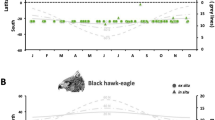Abstract
FACTORS influencing the evolution of clutch size in birds have received notable attention from Kluijver1, Lack2, Wynne-Edwards3 and others. The family Sulidae (order Pelecaniformes) provides a good example of adaptive radiation within a group, different clutch sizes having evolved in a balanced ecological/behaviour system. This problem was studied on the Bass Rock, Scotland (1960–63), the Galapagos Islands (1964) and the Peruvian Guano Island of Guañape Norte (1964–5) for Sula bassana, S. sula, S. dactylatra, S. nebouxii and S. variegata (S. leucogaster data from Murphy4 and Dorward5). Data for S. abbotti are lacking, but this species probably closely resembles S. sula.
This is a preview of subscription content, access via your institution
Access options
Subscribe to this journal
Receive 51 print issues and online access
$199.00 per year
only $3.90 per issue
Buy this article
- Purchase on Springer Link
- Instant access to full article PDF
Prices may be subject to local taxes which are calculated during checkout
Similar content being viewed by others
References
Kluijver, H. N., Ardea, 39, 1 (1951).
Lack, D., The Natural Regulation of Animal Numbers (Oxford University Press, 1954).
Wynne-Edwards, V. C., Animal Dispersion in Relation to Social Behaviour (Edinburgh, 1962).
Murphy, R. C., Oceanic Birds of South America (New York, 1936).
Dorward, D. F., Ibis, 103b, 174 (1962).
Nelson, J. B., Ibis, 106, 63 (1964).
Author information
Authors and Affiliations
Rights and permissions
About this article
Cite this article
NELSON, J. Clutch Size in the Sulidae. Nature 210, 435–436 (1966). https://doi.org/10.1038/210435a0
Issue Date:
DOI: https://doi.org/10.1038/210435a0
This article is cited by
-
Parent-offspring cooperation in the blue-footed boody (Sula nebouxii): social roles in infanticial brood reduction
Behavioral Ecology and Sociobiology (1986)
Comments
By submitting a comment you agree to abide by our Terms and Community Guidelines. If you find something abusive or that does not comply with our terms or guidelines please flag it as inappropriate.



